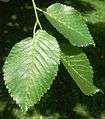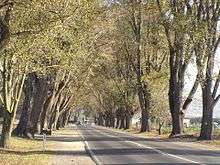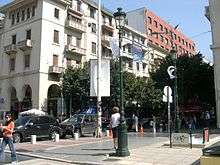Ulmus × hollandica 'Vegeta' (Huntingdon Elm)
| Ulmus × hollandica 'Vegeta' | |
|---|---|
|
'Vegeta', Groningen. | |
| Hybrid parentage | U. glabra × U. minor |
| Cultivar | 'Vegeta' |
| Origin | England |
Ulmus × hollandica 'Vegeta', sometimes known as the Huntingdon Elm,[1] is an old English hybrid cultivar raised at Brampton, near Huntingdon, by nurserymen Wood & Ingram in 1746, allegedly from seed collected from an Ulmus × hollandica hybrid at nearby Hinchingbrooke Park.[2] The tree was given the epithet 'Vegeta' by Loudon, a name previously accorded the Chichester Elm by Donn, as Loudon considered the two trees identical. The latter is indeed a similar cultivar, but raised much earlier in the 18th century from a tree growing at Chichester Hall, Rawreth in Essex.
Description
In areas unaffected by Dutch elm disease, Huntingdon Elms commonly grow to over 35 m, bearing long, straight branches ascending from a short bole < 4 in height; the bole of mature trees has distinctive lattice-patterned bark-ridges[3][4] which serve to distinguish the tree from that other popular U. × hollandica cultivar 'Major', known as 'Dutch Elm', whose bark breaks into small shallow flakes.[5] The glossy, oval leaves have petioles >10 mm long, which serve to distinguish the tree from the Wych Elm, and are very distinctly asymmetric at the base, < 12 cm long by < 7.5 cm broad contracting to an acuminate apex. The leaves are borne on smooth branchlets that never feature corky wings.[6] The tightly-clustered apetalous flowers are bright red, and appear in early spring. The samarae are obovate, < 25 mm long.
Elwes & Henry[2] and Bean[7] attested that the Huntingdon Elm suckers freely, but other writers have stated that it does not sucker at all.[4][8] This contradiction is almost certainly owing to methods of propagation: higher class nurseries grafted cuttings onto Wych Elm stock, which would not produce suckers, whilst others simply rooted the cuttings, which would. A comparatively high percentage of the seed is usually viable.[7]
-

Huntingdon Elm leaves; note long petioles.
-

Huntingdon Elm bark; note lattice pattern.
-

'Vegeta' in Hove Park, East Sussex.
-

Wind-pruned Huntingdon Elm, Southsea Common.
Pests and diseases
The tree has only a slight resistance to Dutch elm disease.
Cultivation
The tree was widely planted in England, particularly between the end of the nineteenth century and the 1930s,[5] owing to its very rapid growth (< 3 m per annum) and attractive wide-spreading form, but its habit of forking sometimes led to splitting of the trunk and premature death. A reputed Huntingdon Elm at Magdalen College, Oxford, was for a time the largest elm known in Britain before it was blown down in 1911. It measured 44 m tall, its trunk at breast height 2.6 m in diameter.[2]However, its calculated age would place its planting long before the introduction of the Huntingdon Elm, and the tree in question was more likely a Chichester Elm.
'Vegeta' was planted in large numbers across Amsterdam after the Second World War as a replacement for 'Belgica' (Belgian Elm), and was itself eventually replaced by the Dutch cultivar 'Dodoens' . 'Vegeta' is also known to have been introduced to Eastern Europe during the 19th century; it was marketed (as U. montana vegeta) in Poland by the Ulrich nursery,[9] Warsaw, and survives in several arboreta. The cultivar has also been planted in avenues in Thessaloniki, Greece, where it is pollarded and pruned to produce a lower, denser crown.[10][11]
Introduced to Australasia, the tree was marketed by several Australian nurseries in the late 19th and early 20th centuries.
Notable trees
The UK TROBI Champion grew at Higham Ferrers in Northamptonshire, measuring 28 m high by 167 cm d.b.h. in 1999 but was felled in 2014;[12] another at Courteenhall in the same county measured 166 cm d.b.h.. In London, many examples still survive, notably around the Millfields Recreation Ground, the largest measuring 31 m high by 88 cm d.b.h..[13] others can be found at Hackney, two in Gibson Square, Islington, and one in Westminster known as The Marylebone Elm.[14] Several dozen planted in the 1920s survive on Southsea Common in Portsmouth, isolated from disease by the sea and urban sprawl.
In Wales one very large tree (NT number 771, last recorded in 1995) stood in the grounds of Powis Castle, near Welshpool; others have been reported from Abergavenny and Caernarfon. Edinburgh has several of note, in the Meadows and Bruntsfield Links, in Inverleith Park, Fettes College, and Abercromby Place. In Éire, 'Vegeta' is represented by a tree at the Kildangan Stud, Kildangan.
Notable plantings in Australia include the Avenue of Honour in Ballarat, and Brisbane Avenue, Canberra.[15] Mature specimens line the main street in Healesville, Victoria.[16] Some very large specimens survive in New Zealand, notably in Auckland where it is considered "the finest of all the elms" in that city. The 16 trees (now only five) planted in 1922 around the rotunda at Auckland Zoo were described as "magnificent... with stately crowns and spreading, drooping branches".[17][18]
-

Huntingdon Elm over 30 m (centre left), Bruntsfield Links, Edinburgh
-

Huntingdon Elms, Bacchus Marsh Avenue of Honour, Victoria[1]
-
Huntingdon Elm, Healesville, Victoria
-

Pollarded 'Vegeta', Tsimiski Street, Thessaloniki, 2006
- ^ vhd.heritage.vic.gov.au/reports/report_place/4957
The 'weeping Huntingdon Elm'
A mature weeping elm survives (2010) near Actons Farm in the vicinity of the Rivers Nursery, Sawbridgeworth, Hertfordshire, which closed in the 1980s. The tree has leaves of similar size to those of the Huntingdon Elm, but slightly oblong in shape, and often either revolute or convolute. The weeping elm once grown at Kew as 'Wentworth Pendula' was identified by Melville as U. × vegeta. The proximity of the Actons tree to the Rivers Nursery would seem more than coincidence, as the nursery was known to have sold seedlings, rather than clones, of the Huntingdon Elm, a practice which resulted in a lawsuit brought by a disgruntled nurseryman at the Oxford Assizes in 1847.[19] F1 hybrids between Wych and Field Elm (e.g. Huntingdon Elm) are fully fertile, but produce widely variant progeny.[20]
Henry Elwes noted in Hertfordshire, and along the western borders of Essex, 'the most graceful form of this tree may be seen in perfection', however he identified it as Ulmus nitens (Ulmus minor).[2]
Synonymy
- Ulmus huntingdonensis: Dieck (Zöschen, Germany) Haupt-Cat. Nachtrag 1, 1887, p. 28.
- Ulmus huntingdonii Hort.: Rehder, in Bailey, Stand. Cycl. Hort. 6: 3411, 1917, in synonymy.
Hybrid cultivars
- 'Commelin'. U.'260' (Ulmus × hollandica × Ulmus pumila) raised at Wageningen but never commercially released; a few specimens survive as part of the Brighton & Hove CC NCCPG Elm Collection at Happy Valley Park, Woodingdean, and at the Wijdemeren City Council Elm collection in The Netherlands, five were planted on the Overmeerseweg and Dammerweg in Nederhorst den Berg in 2015.
Accessions
North America
- Holden Arboretum. Acc. no. 70–128
- Morton Arboretum. Acc. nos. 593–30, 71–70
- New York Botanical Garden. Acc. no. 529/89
- United States National Arboretum, Washington D.C., Acc. no. PI38492
Europe
- Bodnant Garden, Conwy, Wales. No accession details.
- Brighton & Hove City Council, UK, NCCPG Elm Collection .
- Hortus Botanicus Nationalis, Salaspils, Latvia. One tree, planted 1998, acc. no. 18127.
- Rainis Park, Liepāja, Latvia. Two trees, planted before 1994.
- Royal Botanic Garden Edinburgh. Acc. no. 19699364
- Westonbirt Arboretum , Tetbury, Glos., UK. Two trees, one without planting date or acc. no., the other planted 2001, acc. no. 1999/118.
- Wijdemeren City Council, Netherlands, Elm Collection. 3 trees planted around 1970 Spiegelweg, Nederhorst den Berg.
Australasia
- Avenue of Honour, Ballarat, Australia. Details not known.
- Box Hill, (central plantation), Victoria, Australia. Details not known.
- Colac Botanic Gardens, Australia. Details not known.
- Eastwoodhill Arboretum , Gisborne, New Zealand. 3 trees, details not known.
- Fawkner Park, South Yarra, Australia. Details not known.
- Kyneton Botanic Gardens, Kyneton, Australia. Details not known.
- Royal Botanic Gardens, Melbourne , Australia
- Waite Arboretum , University of Adelaide, Adelaide, Australia. Acc. no. 336
Nurseries
Australasia
Europe
- Noordplant , Glimmen, Netherlands
References
- ↑ "BSBI List 2007". Botanical Society of Britain and Ireland. Archived from the original (xls) on 2015-02-25. Retrieved 2014-10-17.
- 1 2 3 4 Elwes, H. J. & Henry, A. (1913). The Trees of Great Britain & Ireland. Vol. VII. 1848–1929. Republished 2014 Cambridge University Press, ISBN 9781108069380
- ↑ White, J. & More, D. (2002). Trees of Britain and northern Europe. Cassell, London.
- 1 2 Rackham, O. (1976). Trees and Woodland in the British Landscape. J. M. Dent, London.
- 1 2 Hanson, M. W. (1990). Essex Elm. Essex Naturalist, 10. Essex Field Club, 1990.
- ↑ Diagnostic photographs of young and mature Huntingdon elms, http://archive.is/Ty0k. Archived from the original on 2012-08-01. Missing or empty
|title=(help) - 1 2 Bean, W. J. (1981). Trees and shrubs hardy in Great Britain, 7th edition. Murray, England.
- ↑ Gurney, R. (1958). Trees of Britain. Faber & Faber, London.
- ↑ Ulrich, C. (1894), Katalog Drzew i Krezewow, C. Ulrich, Rok 1893-94, Warszawa
- ↑ Pollarded 'Vegeta', Tsimiski Street, Thessaloniki, panoramio.com
- ↑ Diamandis, S., & Perlerou, C., 'Resistance test of Greek field elm against DED', p.157 Δoκιμή ανθεκτικότητας ελληνικών γενoτύπων πεδινής φτελιάς (Ulmus minor) κατά της Oλλανδικής ασθένειας, Σ. Διαμαντής και X. Περλέρου
- ↑ "Huntingdon elm felled in Higham Ferrers". 2014.
- ↑ Johnson, O. (2011). Champion Trees of Britain & Ireland, p. 169. Kew Publishing, Kew, London; ISBN 9781842464526.
- ↑ Article on The Marylebone Elm, Trees for Cities web-page
- ↑ Spencer, R., Hawker, J. and Lumley, P. (1991). Elms in Australia. Australia: Royal Botanic Gardens, Melbourne. ISBN 0-7241-9962-4
- ↑ Spencer, Roger, ed., Horticultural Flora of South-Eastern Australia, Vol. 2 (Sydney, 1995), p.112
- ↑ Auckland Botanical Society Journal (2003). Vol. 58 (1), June 2003. ISSN 0113-4132
- ↑ Photograph of Huntingdon Elm, Point Erin Park, Herne Bay, New Zealand, bts.nzpcn.org.nz
- ↑ Ingram, J. (1847). The Huntingdon Elm - Bates v. Rivers. Gardeners' Chronicle, 526.
- ↑ Richens, R. H. (1983). Elm. Cambridge University Press.